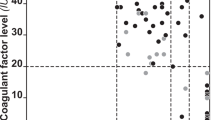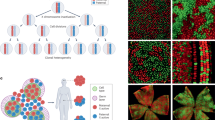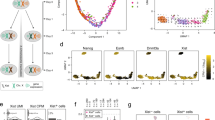Abstract
A basic tenet of the Lyon hypothesis is that X inactivation occurs randomly with respect to parental origin of the X chromosome. Yet, nonrandom patterns of X inactivation are common – often ascertained in women who manifest recessive X-linked disorders despite being heterozygous for the mutation. Usually, the cause of skewing is cell selection disfavouring one of the cell lineages created by random X inactivation. We have identified a three generation kindred, with three females who have haemophilia A because of extreme skewing of X inactivation. Although they have both normal and mutant factor VIII (FVIII) alleles, only the mutant one is transcribed; and, they share an XIST allele that is never transcribed. The skewing in this case seems to result from an abnormality in the initial choice process, which prevents the chromosome bearing the mutant FVIII allele from being an inactive X.
Similar content being viewed by others
Log in or create a free account to read this content
Gain free access to this article, as well as selected content from this journal and more on nature.com
or
References
Seeler RA, Vnencak-Jones CL, Bassett LM, Gilbert JB, Michaelis RC : Severe haemophilia A in a female: a compound heterozygote with nonrandom X-inactivation. Haemophilia 1999; 5: 445–449.
David D, Morais S, Ventura C, Campos M : Female haemophiliac homozygous for the factor VIII intron 22 inversion mutation, with transcriptional inactivation of one of the factor VIII alleles. Haemophilia 2003; 9: 125–130.
Mazurier C, Parquet-Gernez A, Gaucher C, Lavergne JM, Goudemand J : Factor VIII deficiency not induced by FVIII gene mutation in a female first cousin of two brothers with haemophilia A. Br J Haematol 2002; 119: 390–392.
Migeon BR, McGinniss MJ, Antonarakis SE et al: Severe hemophilia A in a female by cryptic translocation: order and orientation of factor VIII within Xq28. Genomics 1993; 16: 20–25.
Valleix S, Vinciguerra C, Lavergne JM, Leuer M, Delpech M, Negrier C : Skewed X-chromosome inactivation in monochorionic diamniotic twin sisters results in severe and mild hemophilia A. Blood 2002; 100: 3034–3036.
Nance WE : Do twin Lyons have larger spots? Am J Hum Genet 1990; 46: 646–648.
Nisen PD, Waber PG : Nonrandom X chromosome DNA methylation patterns in hemophiliac females. J Clin Invest 1989; 83: 1400–1403.
Acquila M, Caprino D, Bicocchi P, Mori PG, Tagliaferri AR : A skewed lyonization phenomenon as cause of hemophilia A in a female patient. Blood 1995; 85: 599–600.
Favier R, Lavergne JM, Costa JM et al: Unbalanced X-chromosome inactivation with a novel FVIII gene mutation resulting in severe hemophilia A in a female. Blood 2000; 96: 4373–4375.
Coleman R, Genet SA, Harper JI, Wilkie AO : Interaction of incontinentia pigmenti and factor VIII mutations in a female with biased X inactivation, resulting in haemophilia. J Med Genet 1993; 30: 497–500.
Sharp A, Robinson D, Jacobs P : Age- and tissue-specific variation of X chromosome inactivation ratios in normal women. Hum Genet 2000; 107: 343–349.
Puck JM, Willard HF : X inactivation in females with X-linked disease. N Engl J Med 1998; 338: 325–328.
Migeon BR : Non-random X chromosome inactivation in mammalian cells. Cytogenet Cell Genet 1998; 80: 142–148.
Raynaud M, Moizard MP, Dessay B et al: Systematic analysis of X-inactivation in 19XLMR families: extremely skewed profiles in carriers in three families. Eur J Hum Genet 2000; 8: 253–258.
Avner P, Heard E : X chromosome inactivation: counting, choice and initiation. Nat Rev Genet 2001; 2: 59–67.
Percec I, Plenge RM, Nadeau JH, Bartolomei MS, Willard HF : Autosomal dominant mutations affecting X inactivation choice in the mouse. Science 2002; 296: 1136–1139.
Brown CJ, Hendrich BD, Rupert JL et al: The human XIST gene: analysis of a 17 kb inactive X-specific RNA that contains conserved repeats and is highly localized within the nucleus. Cell 1992; 71: 527–542.
Hendrich BD, Brown CJ, Willard HF : Evolutionary conservation of possible functional domains of the human and murine XIST genes. Hum Mol Genet 1993; 2: 663–672.
Oldenburg J, Ivaskevicius V, Rost S et al: Evaluation of DHPLC in the analysis of hemophilia A. J Biochem Biophys Methods 2001; 47: 39–51.
Bicocchi MP, Pasino M, Lanza T et al: Analysis of 18 novel mutations in the factor VIII gene. Br J Haematol 2003; 122: 810–817.
Plenge RM, Hendrich BD, Schwartz C et al: A promoter mutation in the XIST gene in two unrelated families with skewed X-chromosome inactivation. Nat Genet 1997; 17: 353–356.
Allen RC, Zoghbi HY, Moseley AB, Rosenblatt HM, Belmont JW : Methylation of HpaII and HhaI sites near the polymorphic CAG repeat in the human androgen-receptor gene correlates with X chromosome inactivation. Am J Hum Genet 1992; 51: 1229–1239.
Rupert JL, Brown CJ, Willard HF : Direct detection of non-random X chromosome inactivation by use of a transcribed polymorphism in the XIST gene. Eur J Hum Genet 1995; 3: 333–343.
Kemball-Cook G, Tuddenham EG, Wacey AI : The factor VIII structure and mutation resource site: HAMSTeRS version 4. Nucleic Acids Res 1998; 26: 216–219.
Pereira LV, Zatz M : Screening of the C43G mutation in the promoter region of the XIST gene in females with highly skewed X-chromosome inactivation. Am J Med Genet 1999; 87: 86–87.
Naumova AK, Plenge RM, Bird LM et al: Heritability of X chromosome-inactivation phenotype in a large family. Am J Hum Genet 1996; 58: 1111–1119.
Naumova AK, Olien L, Bird LM et al: Genetic mapping of X-linked loci involved in skewing of X chromosome inactivation in the human. Eur J Hum Genet 1998; 6: 552–562.
Author information
Authors and Affiliations
Corresponding author
Rights and permissions
About this article
Cite this article
Bicocchi, M., Migeon, B., Pasino, M. et al. Familial nonrandom inactivation linked to the X inactivation centre in heterozygotes manifesting haemophilia A. Eur J Hum Genet 13, 635–640 (2005). https://doi.org/10.1038/sj.ejhg.5201386
Received:
Revised:
Accepted:
Published:
Issue date:
DOI: https://doi.org/10.1038/sj.ejhg.5201386
Keywords
This article is cited by
-
X Chromosome inactivation: a modifier of factor VIII and IX plasma levels and bleeding phenotype in Haemophilia carriers
European Journal of Human Genetics (2021)
-
X-chromosome inactivation: implications in human disease
Journal of Genetics (2021)
-
Determining the role of skewed X-chromosome inactivation in developing muscle symptoms in carriers of Duchenne muscular dystrophy
Human Genetics (2016)
-
Detailed analysis of X chromosome inactivation in a 49,XXXXX pentasomy
Molecular Cytogenetics (2009)
-
X chromosome inactivation in clinical practice
Human Genetics (2009)



